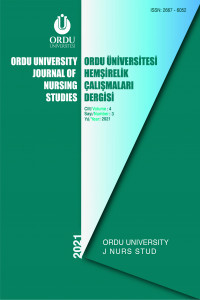Serebral Palsi, Osteomyelit ve Epilepsi Tanısı Bulunan Çocuğun Bilişsel Gelişim Kuramı ve Yaşam Modeline Göre Hemşirelik Bakımının Planlanması: Olgu Sunumu
Hemşirelik kuram ve modelleri hemşirelik uygulamalarının bir sistem ve disiplin içerisinde yapılmasını hedeflemektedir. Ayrıca hastanın bakım önceliklerinin belirlenip hastanın bütüncül ele alınarak değerlendirilmesini ve her hasta için uygun kuram ve bakım modelinin kullanılmasını sağlamaktadır. Bu amaçla Serebral Palsi (SP), Osteomyelit ve Epilepsi tanısı bulunan 8 yaşındaki erkek hasta için annesi ile iletişime geçilerek Bilişsel Gelişim Kuramı ve Yaşam Modeline göre hemşirelik bakımı planlanmıştır.
Bu vakanın yaşıtlarına göre bilişsel gelişiminin geride kaldığı ve günlük yaşam aktivitelerini karşılamakta yetersiz olduğu görülmüştür. Bu nedenle Bilişsel Gelişim Kuramı ve Yaşam Modeli birbirine entegre edilerek, yaşam modeli içerisinde yer alan 12 adet yaşam aktiviteleri doğrultusunda çocuğun gereksinimleri ile ilgili tanılar konulmuş ve yapılabilecek hemşirelik girişimleri belirlenmiştir. Bu çalışma, Bilişsel Gelişim Kuramı ve Yaşam Modeli doğrultusunda, Serebral Palsi, Osteomyelit ve Epilepsi tanısı olan çocuklara ve onların bakımlarında yardımcı olan kişilere ihtiyaç duydukları bilgi ve desteği sağlamayı amaçlamaktadır.
Anahtar Kelimeler:
Serebral Palsi, Osteomyelit, Epilepsi, Kuram, Model
Planning Nursing Care According to Cognitive Development Theory and Life Model of Child Diagnosed with Cerebral Palsy, Osteomyelitis and Epilepsy: A Case Report
Nursing theories and models aim to make nursing practices within a system and discipline. In addition, it ensures that the patient’s care priorities are determined, the patient is handled and evaluated holistically, and the appropriate theory and care model is used for each patient. For this purpose, nursing care was planned according to Cognitive Development Theory and Life Model for an 8-year-old male patient that is diagnosed with Cerebral Palsy (CP), Osteomyelitis and Epilepsy, by communicating with his mother. It was observed that the cognitive development of this case lagged behind compared to her peers and was insufficient to meet the activities of daily living. For this reason, by integrating Cognitive Development Theory and Life Model, diagnoses related to the needs of the child were made in line with the 12 life activities included in the life model and nursing interventions that could be made were determined. This study aims to provide the information and support they need to children diagnosed with Cerebral Palsy, Osteomyelitis, and Epilepsy and people who help them in their care, in line with Cognitive Development Theory and Life Model.
Keywords:
Cerebral Palsy, Epilepsy, Theory, Model, Osteomyelitis,
___
- Beghi E. (2020). The epidemiology of epilepsy. Neuroepidemiology, 54, 185-191. https://doi.org/10.1159/000503831.
- Çağlıyan B, Köse U. (2021). Epilepsi EEG verilerinin makine öğrenmesi teknikleriyle sınıflandırılması. Avrupa Bilim ve Teknoloji Dergisi, 23, 163-172. https://doi.org/10.31590/ejosat.857507.
- Çalışır H, Karabudak SS, Karataş P, Meşealan İ, Tosun FA. (2018). Serebral palsili çocuğu olan annelerin aile yükü ve umutsuzluk düzeyleri. Dokuz Eylül Üniversitesi Hemşirelik Fakültesi Elektronik Dergisi, 11(2), 147-156.
- Çapri B, Çelikkaleli Ö. (2005). İlköğretim birinci kademedeki (7-11 yaş grubu) çocukların korunum gelişim düzeylerinin cinsiyet ve sınıf değişkenleri açısından incelenmesi. Mersin Üniversitesi Eğitim Fakültesi Dergisi, 1(1), 48-65.
- Gornitzky LA, Kim AE, Donnell MJ, Swarup I. (2020). Diagnosis and management of osteomyelitis in children: A critical analysis review. Journal of Bone and Joint Surgery Reviews, 8(6), 1-12.
- Graham HK, Rosenbaum P, Paneth N, Dan B, Lin J, Damiano D. (2016). Cerebral palsy. Nature Reviews Disease Primers, 2, 1-24. https://doi.org/ 10.1038 /nrdp.2015.82.
- Holland K, Jenkins J, Solomon J, Whittam S. (2003). Applying the Roper-Logan-Tierney model in practice. Edinburg: Churchill Livingstone.
- Karadağ A, Çalışkan N, Baykara GZ. (2018). Hemşirelik teorileri ve modelleri. 1. Baskı, İstanbul, p. 532-572.
- Kaya N. (2012). Yaşam Modeli. Babadağ K, Atabek Aşti T. (Ed.). Hemşirelik esasları uygulama rehberi. Gözden geçirilmiş 2. Baskı, İstanbul: İstanbul Medikal Sağlık ve Yayıncılık Hiz. Tic. Ltd. Şti., s. 1-7.
- Martin AC, Anderson D, Lucey J, Guttinger R, Jacoby PA, Mok TJ. (2016). Predictors of outcome in pediatric osteomyelitis: five years experience in a Single Tertiary Center. Pediatric Infectious Disease Journal, 35(4), 387-391. https://doi.org/10.1097/INF.0000000000001031.
- Patel DR, Neelakantan M, Pandher K, Merrick J. (2020). Cerebral palsy in children: A clinical overview. Translational Pediatrics, 9(1), 125-135. https://doi.org/10.21037/tp.2020.01.01.
- Roper N, Logan WW, Tierney AJ. (2000). The model of living, Roper-Logan-Tierney model of nursing: based on activities of living, Edingburg: Churchill Livingstone.
- Türk ÇA, Deveci H, Özel S. (2020). Serebral palsi tanısı ile izlediğimiz hastalarda botulinum toksin kullanımı, Fiziksel Tıp ve Rehabilitasyon Bilimleri Dergisi, 23(3), 162-6. https://doi.org/10.31609/jpmrs.2019-72311.
- Wu Y, McLeod C, Blyth C, Bowen A, Martin A, Nicholson AE, et al. (2020). Predicting the causative pathogen among children with osteomyelitis using Bayesian networks–improving antibiotic selection in clinical practice. Artificial Intelligence In Medicine, 107, 1-11. https://doi.org/10.1016/j.artmed. 2020. 101 895.
- Yiğit R. (2020). Çocukluk dönemlerinde büyüme ve gelişme. 2. Baskı, Güneş Tıp Kitabevleri, s. 101-108.
- Yayın Aralığı: Yılda 3 Sayı
- Başlangıç: 2018
- Yayıncı: Ordu Üniversitesi
Sayıdaki Diğer Makaleler
Hemşirelik Öğrencilerinin Üreme Sağlığı Tutumlarının Belirlenmesi
Ferdane KOÇOĞLU, Semra KOCAÖZ, Pınar KARA
Bağırsak Stoması Bulunan Hastaların Tekrar Hastaneye Yatış Nedenlerinin İncelenmesi
Esra MAKAL ORĞAN, Sacide YILDIZELİ TOPÇU, Mervegül ÖZKAN
Nazlı BALTACI, Hümeyra TÜLEK DENİZ
Kronik Hastalığı Olan Bireylerin COVID-19 Kaynaklı Stres ve Anksiyete Düzeyleri: Karaman İli Örneği
Covid-19 Pandemisinde Hemşirelik Süreci
COVID-19 Pandemi Sürecinde Aile Planlaması Hizmetleri, Yöntem Kullanımı ve Karşılaşılan Sorunlar
Nurhan DOĞAN, Gonca ÜSTÜN, Merve ÇAYIR YILMAZ
COVID-19 Pandemisinde Yeni Deneyimler: Uzaktan Eğitime İlişkin Öğrenci Görüşleri
Menopoz Döneminde Vazomotor Semptomlarda Fitoöstrojen Kullanımı
